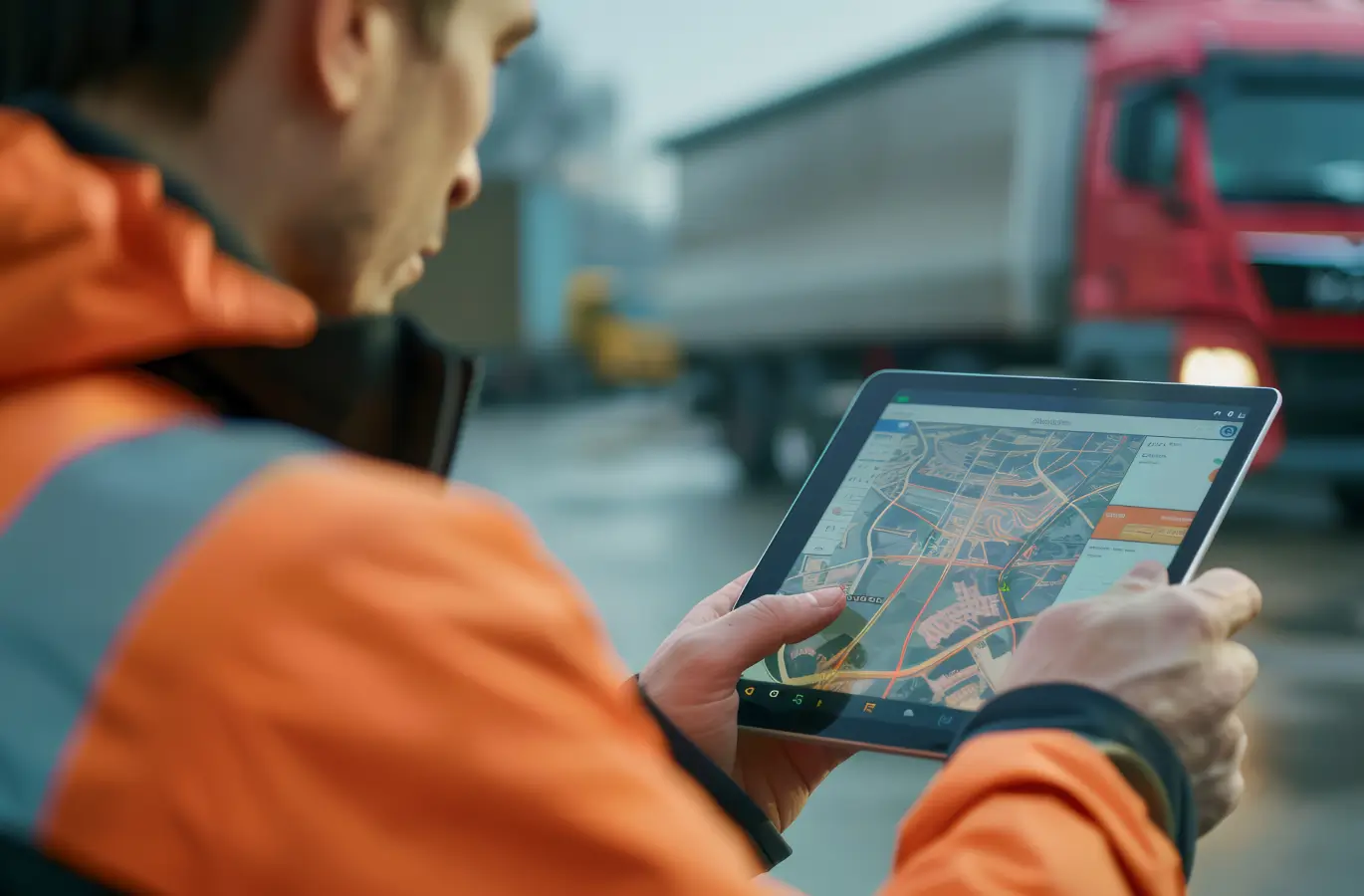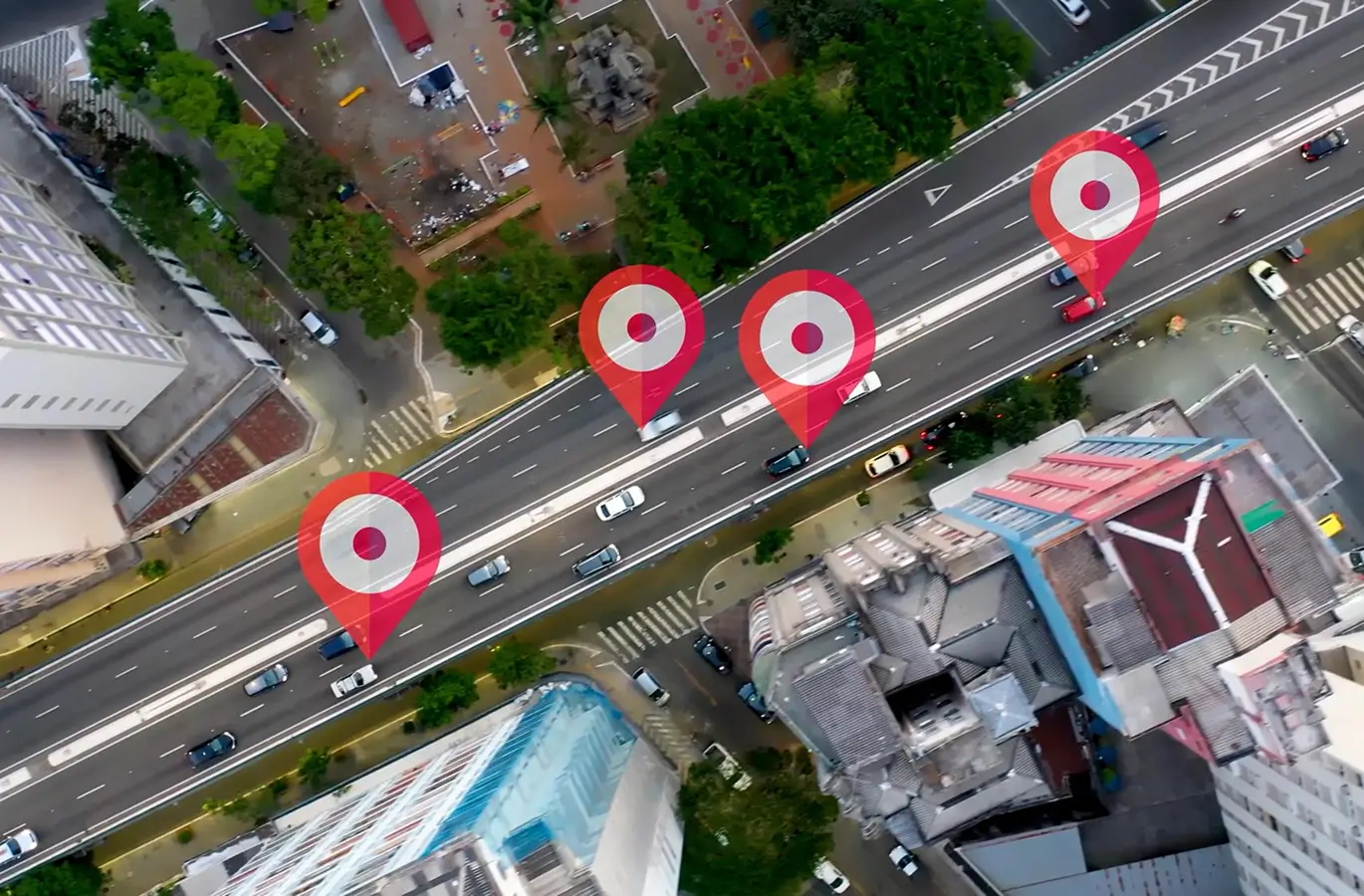GPS fleet management is transforming logistics by providing real-time visibility of vehicles, which is now essential for all fleet sizes, not just large enterprises. This technology enhances operational efficiency, simplifies compliance like DVIR, improves customer satisfaction through transparent updates, and increases accountability by tracking vehicle activity. Platforms like REACH 24 integrate GPS tracking with digital compliance tools for a unified, mobile-first workflow.
Logistics operations are under more pressure than ever. Customers expect real-time updates. Delivery windows are tighter. Even a small delay can impact both service quality and customer trust. In this environment, knowing where your vehicles are and what they are doing is no longer a luxury.
This is where GPS fleet management steps in.
By 2026, GPS tracking will have become a standard across the logistics industry. It is no longer reserved for large enterprises with hundreds of trucks.
Regional couriers, mid-sized fleets, and even small delivery services now rely on GPS to enhance coordination, monitor vehicle status, and respond more quickly to unexpected changes.
The technology itself is well-established. What has changed is how logistics teams utilize it not just for tracking, but also for simplifying daily operations, enhancing accountability, and maintaining workflow efficiency.
Whether you’re managing a handful of delivery vans or coordinating a growing regional fleet, GPS fleet management helps you stay on top of your operations, reduce confusion, and deliver with confidence.
This article explores how GPS fleet management is transforming logistics in 2026. We’ll cover how the technology works, the practical benefits it delivers, and why it is now essential for companies that want to stay competitive and customer-focused.
What GPS Fleet Management Means
GPS fleet management utilizes satellite-based tracking to monitor the location, movement, and status of your vehicles in real-time. It provides dispatchers, managers, and owners with a live view of fleet activity, which is especially valuable for coordinating deliveries, managing delays, and making time-sensitive decisions.
Each vehicle is equipped with a GPS tracking device or a mobile app that sends location data at regular intervals. This data feeds into a central platform that displays live locations on a map, along with trip history and status updates.
Here’s what GPS fleet tracking typically includes:
- Live location updates
See where each vehicle is at any moment. This helps reduce unnecessary phone calls and speeds up decision-making. - Trip and movement history
Review past routes, stop durations, and travel times to optimize your schedule. This supports performance tracking and delivery verification. - Status alerts
Receive notifications when a vehicle arrives, departs, or idles unexpectedly. - Geofencing
Set virtual zones on a map and get alerted when vehicles enter or exit those areas. - Mobile access
Track and manage fleets from a smartphone or tablet, ideal for logistics managers on the go.
The strength of GPS tracking lies in its simplicity. It gives you instant clarity without requiring heavy analytics or complex systems. It helps teams respond faster and coordinate smarter, especially when managing multiple drivers and moving parts.
Some platforms may offer predictive features that analyze historical data to forecast issues or optimize routes. These tools often require large data sets, dedicated analysts, or AI models. For most small to mid-sized fleets, they may not be practical or necessary.
In contrast, reliable real-time tracking remains the most valuable function for logistics teams, giving them the insight they need without the clutter of features they will not use.
Key Benefits of GPS Fleet Management for Logistics Operations
Logistics success relies on timing, coordination, and visibility. GPS fleet management supports all three by providing real-time insight into how vehicles are moving and where potential bottlenecks exist. It eliminates guesswork from dispatch and enables managers to take swift, informed action.
Below are the most valuable benefits GPS tracking delivers to logistics operations in 2026.
1. Real-Time Operational Visibility
The most immediate value of GPS tracking is knowing the exact location of every vehicle at any given moment. This visibility reduces reliance on phone calls, improves dispatching, and gives managers a clear view of day-to-day operations.
- See live vehicle locations on a digital map
- Track progress across delivery routes or job sites
- Identify when vehicles arrive, leave, or stop unexpectedly
This level of visibility enables businesses to stay agile, particularly when routes change, delays occur, or high-priority deliveries need to be rerouted.
2. Faster Response to Delays and Incidents
Unexpected traffic, mechanical issues, or driver delays are part of logistics. GPS fleet tracking helps operators respond immediately.
- Get notified when a vehicle stops for too long
- Reassign deliveries based on who is closest
- Communicate more clearly with customers using live updates
When you are aware of what is happening on the road, you can act quickly and minimize the impact of disruptions.
3. Simplified Compliance and Reporting
Compliance requirements, such as DVIR (Driver Vehicle Inspection Reports), are essential for keeping vehicles safe and compliant with legal regulations. GPS tracking can support these efforts by creating an audit trail of activity and providing documentation on vehicle movements.
- Pair GPS data with inspection logs
- Verify if vehicles followed designated routes or timelines
- Maintain historical movement records for audits
Note: REACH 24 supports DVIR compliance and GPS visibility together, making it easier for small logistics teams to handle daily compliance without the need for additional systems.
4. Greater Customer Satisfaction Through Transparency
Customers increasingly want updates about their deliveries. GPS fleet tracking makes it easier to share accurate information.
- Confirm delivery times
- Update customers when a vehicle is approaching
- Handle delays with proactive communication
This level of transparency fosters trust, particularly in service models where on-time delivery is a key competitive advantage.
5. Reduced Internal Confusion and Manual Work
GPS tracking reduces the number of phone calls and the amount of guesswork needed to run logistics operations.
- Drivers are not constantly asked for location updates
- Dispatchers can make quicker decisions
- Managers spend less time reconciling job records
A clear view of fleet movement leads to fewer misunderstandings and faster execution.
6. Safer and More Accountable Operations
When vehicle activity is tracked, accountability improves. Drivers are more consistent, and risky behavior is reduced.
Some systems use GPS data to generate behavior scores or safety metrics. While this may benefit larger fleets, small businesses often find that simple visibility is enough to encourage safer habits.
GPS Fleet Management in Action: Real-World Usage
Understanding the benefits of GPS tracking is one thing. Seeing how it improves daily logistics brings those benefits into focus. Whether you’re managing scheduled deliveries, service visits, or last-mile distribution, GPS fleet tracking creates the structure logistics teams need to stay on time and in control.
Here are common scenarios where GPS tracking makes an immediate impact:
1. Coordinating Citywide Deliveries
A same-day courier service with ten vehicles used to rely on phone calls for status updates. Delays were common, and customer communication was inconsistent.
With GPS tracking, dispatchers now view live vehicle locations. If a driver is delayed by traffic, another nearby vehicle is reassigned. Deliveries arrive on time, and customers receive accurate updates — no more guesswork.
2. Tracking Job Completion in the Field
A logistics provider with mobile repair technicians struggled with inconsistent job status updates.
Now, GPS tracking logs when a vehicle arrives and leaves a site. Job progress is tied to location data, giving the office team real-time visibility without the need for manual check-ins.
3. Improving Client Communication
A company handling warehouse transfers for retailers needed a better way to update clients.
GPS tracking now powers a shared portal that shows vehicle movement. Clients can track shipments as they are en-route or experience delays. This transparency reduces complaints and builds trust, even during disruptions.
4. Reducing Idle Time and Boosting Utilization
A regional distribution fleet sought to avoid purchasing additional vehicles. GPS data revealed long periods of inactivity during certain shifts.
The team adjusted schedules and routes to improve usage — achieving better productivity without expanding the fleet.
These kinds of insights are hard to uncover without real-time tracking data
5. Integrating GPS Tracking with DVIR Compliance
Fleet tracking isn’t just about location. It is also about making sure every vehicle on the road is safe and legal to operate. This is where GPS tracking and DVIR (Driver Vehicle Inspection Reports) work together to support a complete logistics workflow.
REACH 24 combines both into one system — helping logistics teams track vehicles and manage compliance without needing to switch tools.
What DVIR Means for Fleet Operations
DVIRs, or Daily Vehicle Inspection Reports, are documents that drivers complete before and after using a vehicle. They help identify mechanical issues early and create a safety record for audits or insurance checks.
Paper forms can get lost or missed. A digital DVIR system ensures inspections are completed, stored, and accessible when needed — even for small fleets.
How GPS and DVIR Work Together in REACH 24
REACH 24 allows drivers to complete inspection checklists, report defects, and upload photos from the field. These records are stored alongside real-time GPS data, providing managers with a comprehensive context in one place.
- Know which vehicle was inspected and when
- Verify inspections before a vehicle hits the road
- Respond quickly to defects with location and timeline details
For example, if a driver flags a brake issue mid-route, GPS tracking shows the vehicle’s current location. This helps dispatchers arrange service, reroute deliveries, or assess urgency on the spot.
Simplifying the Compliance Workflow
For many logistics companies, especially smaller ones, managing both location tracking and compliance can be a daunting task. By integrating GPS with DVIR in a single platform, REACH 24 simplifies operations.
There is no need for multiple apps, separate systems, or extra training. Drivers use a single interface to complete inspections and track their movements. Managers log in once to see both vehicle status and inspection history.
This unified approach helps teams:
- Reduce missed inspections
- Respond faster to defects or issues
- Maintain clearer records for audits or insurance
- Ensure that vehicles are both moving efficiently and operating safely
What GPS Can’t Replace (And That’s Okay)
GPS fleet tracking is powerful, but it is not designed to handle everything. For logistics teams, knowing what GPS does not do helps set clear expectations and avoid unnecessary complexity.
Here are four things GPS fleet management does not cover and why that is often beneficial for small to mid-sized operations.
1. Predictive Maintenance
GPS does not forecast vehicle failures. Predictive maintenance relies on in-depth diagnostic data and advanced analytics. REACH 24 supports issue logging through inspections, which is typically sufficient for fleets that adhere to regular service intervals.
2. Driver Behavior Monitoring
Speed, harsh braking, and idle time tracking require telematics solutions that go beyond GPS. REACH 24 does not monitor driving behavior. For many teams, route history and time logs already provide practical accountability.
3. Automated Route Optimization
Optimizing routes based on traffic or delivery windows involves complex planning tools. REACH 24 offers trip history and location awareness without interfering with how drivers choose their routes.
4. Fuel or Emission Tracking
Fuel use and carbon data come from vehicle systems or third-party sensors. REACH 24 does not support this. Its focus is on safety and compliance, not sustainability reporting.
Why Simpler Works
Most logistics teams benefit more from clarity than complexity. GPS fleet management helps them track vehicles, manage compliance, and stay efficient — without extra features that slow things down.
Choosing GPS Fleet Management Software in 2026
With numerous options available on the market, finding the ideal GPS fleet management tool can be a daunting task. But the decision becomes easier when you focus on what truly matters for your logistics operation — visibility, compliance, and ease of use.
Here are the key factors to look for when evaluating GPS tracking software in 2026.
1. Real-Time Accuracy
A GPS is only useful if it shows accurate, real-time data. Lagging updates or unclear maps create confusion.
Ask:
- How often is location data refreshed?
- Is the map interface easy to read and reliable?
2. Mobile Access
Your team is always on the move. The software should function equally well on a phone as it does on a computer.
Ask:
- Can drivers and managers track and update from mobile devices?
- Are inspections and job check-ins mobile-friendly?
3. Simplicity
If your team cannot use it immediately, it will not be of benefit to you. The best tools require little training and make daily tasks easier.
Ask:
- Can someone new pick it up in 30 minutes or less?
- Does it make your workflow faster?
4. Built-In Compliance Tools
If you manage DVIRs or inspections, choose software that handles both tracking and compliance in one place.
Ask:
- Can I complete inspections and log issues in the same platform?
- Is inspection history stored for audits?
5. Scalable Pricing
Avoid paying for features meant for massive fleets. Look for plans that fit your size and budget.
Ask:
- Are there flexible options available for fleets with fewer than 20 vehicles?
- Can I upgrade as the fleet grows?
6. Responsive Support
When issues arise, prompt support makes a difference. Reliable onboarding and help should be part of the package.
Ask:
- Is live support easy to REACH 24 during work hours?
- Is there a setup guide or onboarding walkthrough?
7. Focused Value
Skip the platforms that push unnecessary analytics or dashboards. Select a tool that meets your needs, including location tracking, basic reporting, and compliance support.
Ask:
- Does this solve my top priorities?
- Am I paying for features I will not use?
Future Outlook: What to Watch in GPS Telematics
As logistics continues to evolve, GPS telematics remains a cornerstone of fleet visibility. The core function of tracking vehicles in real-time has not changed, but how that data is used is becoming increasingly refined.
For small and mid-sized logistics teams, the priority is adopting only what adds value, without being overwhelmed by complex systems.
Here are five trends shaping the next phase of GPS fleet management.
1. Closer Integration with Compliance
More platforms are expected to integrate GPS tracking with compliance tools like vehicle inspection logs and issue tracking. This would allow teams to manage tasks such as DVIR submissions and defect resolution within the same system used for live tracking.
REACH 24 already supports this streamlined approach by combining GPS visibility with digital DVIR workflows.
2. Mobile-First as the Standard
As field operations become more flexible, logistics professionals require tracking tools that are compatible with any location and environment. The trend is shifting toward platforms that prioritize mobile usability with clear maps, alerts, and inspection tools accessible directly from a phone.
Software that only works well on desktops is quickly falling behind.
3. Smarter Alerts, Less Noise
Some vendors are working to make GPS alerts more context-aware. Instead of overwhelming users with every movement, systems may prioritize relevant updates such as missed geofence entries or prolonged idling, based on what matters to your operation.
This direction supports better decision-making without the risk of notification fatigue.
4. Insurance-Linked Insights
There is an early movement in the insurance industry toward rewarding fleets that can demonstrate consistent safety and inspection practices through telematics. However, not yet widespread, GPS tracking data may begin to influence insurance evaluations for commercial fleets.
The ability to show vehicle movement and inspection history could play a role in lowering risk profiles.
5. Customization Over Complexity
More logistics platforms are adopting modular designs, allowing businesses to activate only the features they need. This prevents small teams from being locked into systems with extra tools they will not use.
REACH 24 reflects this model by focusing on GPS and DVIR for safety, clarity, and daily efficiency.
The GPS Advantage for Logistics
For logistics teams navigating tight schedules and growing demands, GPS fleet management offers a practical advantage. It brings real-time visibility, faster coordination, and clearer accountability to every vehicle on the road.
GPS tracking does not require deep analytics or heavy systems to be effective. It works by showing you what is happening, when, and where — giving your team the information needed to act quickly and confidently.
Paired with tools like DVIR compliance, GPS fleet management becomes more than a tracking solution. It becomes part of a daily workflow that supports safety, performance, and customer satisfaction.
For small and mid-sized logistics operations, the best software is not the one with the most features. It is the one your team can use every day, without hassle.
REACH 24 helps you do just that.
It brings together GPS tracking and DVIR in one simple, mobile-first platform, built for real-world logistics teams that value clarity and control.
Take the next step. Discover how REACH 24 can enhance your logistics operations.
Request a demo today and experience GPS fleet management that works the way you do.
Frequently Asked Questions (FAQs)
-
What is GPS fleet management in logistics?
GPS fleet management refers to the use of satellite-based tracking technology to monitor the location, movement, and activity of vehicles in a logistics fleet. It provides real-time visibility that supports operational decisions, compliance, and customer service.
-
How does GPS tracking improve logistics operations?
GPS tracking enhances dispatch accuracy, reduces delivery delays, improves route planning, and provides real-time updates for both fleet managers and customers. It also supports proactive decision-making in case of traffic or service disruptions.
-
Can GPS fleet management help with compliance?
Yes, especially with DVIR (Driver Vehicle Inspection Reporting). GPS data can time-stamp vehicle check-ins, automate inspection workflows, and ensure regulatory compliance for commercial fleets.
-
Is GPS fleet management only for large logistics companies?
Not at all. Small and mid-sized logistics companies also benefit from GPS fleet solutions, as they can improve fleet visibility, reduce operational waste, and compete more effectively on delivery timelines.
-
Does GPS tracking require constant internet access?
Most GPS tracking systems use cellular networks to transmit data. While real-time access depends on connectivity, the devices still record and store location data even when temporarily offline, which is uploaded once the signal is resumed.
-
How does GPS help with vehicle utilization?
GPS helps monitor which vehicles are active, idle, or underutilized. By analyzing location history and engine data, fleet managers can optimize usage, reduce downtime, and allocate resources more effectively.
-
What is the role of GPS in customer experience?
GPS enables accurate ETAs, live delivery tracking, and proactive notifications to customers in case of delays or rescheduling. This transparency builds trust and improves service satisfaction.
-
Are there privacy concerns with GPS fleet tracking?
GPS tracking for fleet vehicles is typically covered under employment agreements and used solely for business operations. Transparency and policy alignment are key to responsible implementation.



